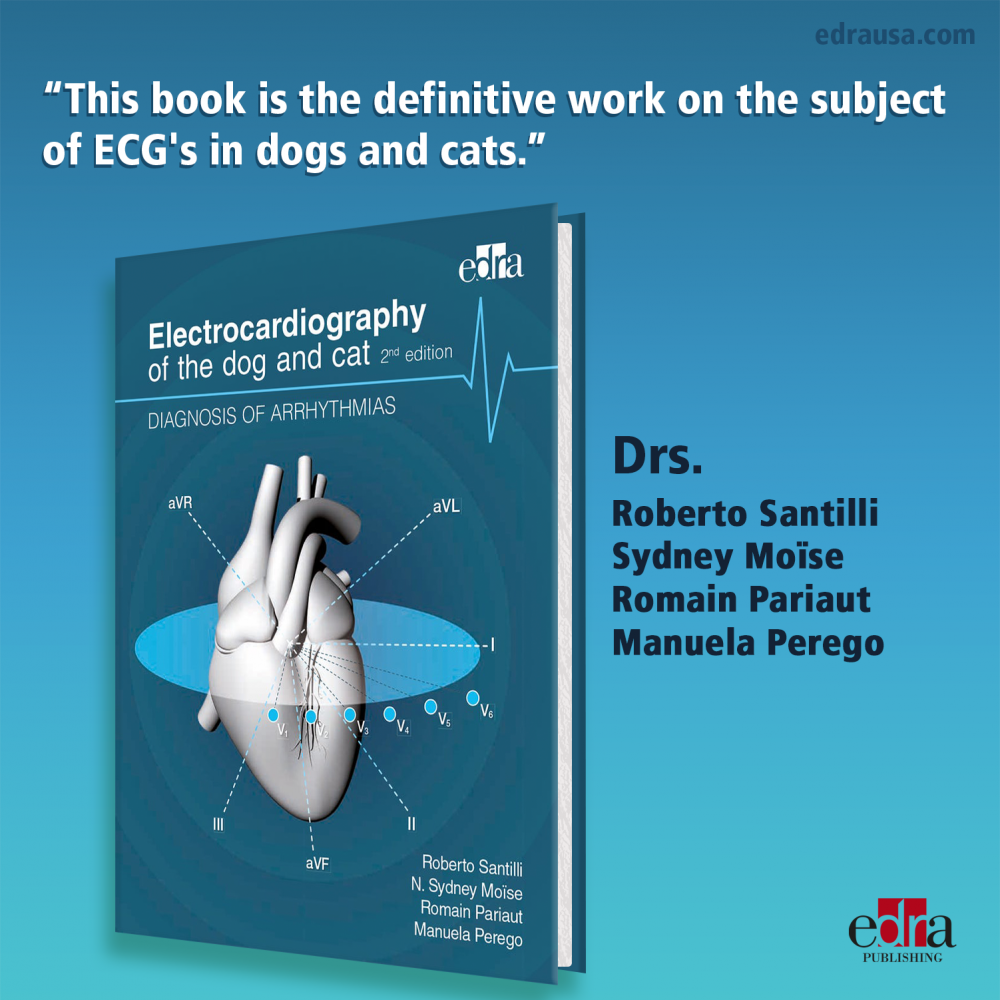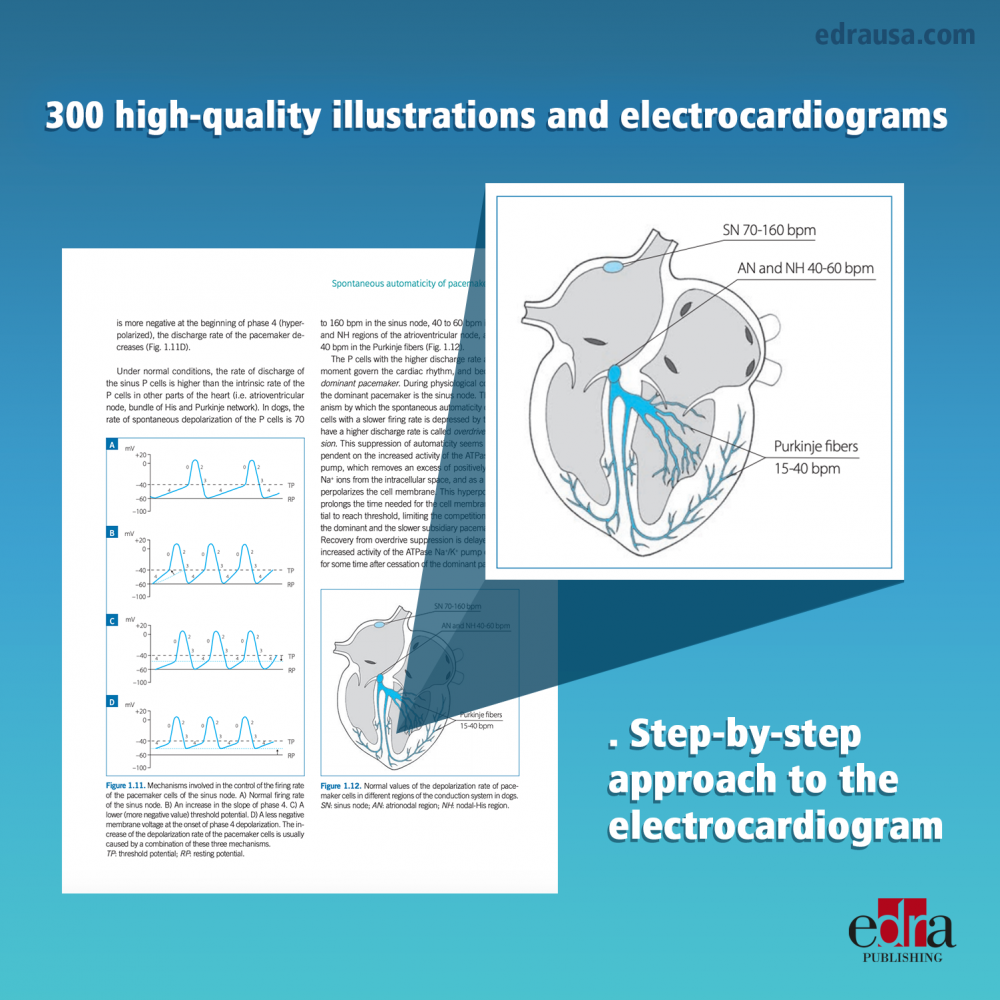
Electrocardiography of the dog and cat. Diagnosis of arrhythmias. II Edition
Electrocardiography of the Dog and Cat (2nd edition) promises to give the student and the specialist both the practical approach of the electrocardiographic diagnosis and the depth of understanding that promotes genuine learning in a subject area that has intrigued clinicians for more than a century. The combined and varied experiences of the authors give strengths to the review of the literature, and the approach to electrocardiogram interpretation in the dog and cat.
Authors
Roberto A. Santilli, Dr. Med. Vet., PhD, DECVIM-CA (Cardiology)
Roberto Santilli graduated from the College of Veterinary Medicine of the University of Milan in 1990. He became a diplomate of the European College of Veterinary Internal Medicine-Companion Animals (Specialty of Cardiology) in 1999. Since 2014, he has been an Adjunct Professor of Cardiology at the Cornell University College of Veterinary Medicine, where he is actively involved in the development of a cardiac electrophysiologic laboratory.
His main research activities include the diagnosis and treatment of arrhythmias in dogs and cats.
N. Sydney Moïse DVM, MS, DACVIM (Cardiology and Internal Medicine)
Sydney Moïse graduated from the College of Veterinary Medicine, Texas A&M University (DVM) and Cornell University (MS). She became a diplomate of the American College of Internal Medicine in 1982 and the subspecialty of Cardiology in 1986. She established the Cardiology Service at Cornell University and is currently Professor in the Department of Clinical Sciences.
Romain Pariaut Dr. Vre., DACVIM (Cardiology) DECVIM-CA (Cardiology)
Romain Pariaut graduated from the School of Veterinary Medicine of Lyon, France, in 1999. He be- came a diplomate of the American College of Internal Medicine (Cardiology Subspecialty) in 2005, and a diplomate of the European College of Internal Medicine- Companion Animals (Specialty of Cardiology) in 2006. Between 2007 and 2015, he was a faculty member in the School of Veterinary medicine at Louisiana State University.
He then joined Cornell University as an Associate Professor in the Department of Clinical Sciences.
Manuela Perego, Dr. Med. Vet.
Manuela Perego graduated from the College of Veterinary Medicine of the University of Milan in 2003. She completed a residency program of the European College of Veterinary.
Electrocardiography of the Dog and Cat (2nd edition) promises to give the student and the specialist both the practical approach of the electrocardiographic diagnosis and the depth of understanding that promotes genuine learning in a subject area that has intrigued clinicians for more than a century. The combined and varied experiences of the authors give strengths to the review of the literature, and the approach to electrocardiogram interpretation in the dog and cat.
- 14 detailed chapters emphasize important key points in the assessment of the electrocardio- gram, including vectors of depolarization and repolarization, relationship of cardiac structure to electrophysiology, detailed steps for electrocardiographic interpretation, hemodynamic conse- quences of rhythm disorders, new understanding of supraventricular arrhythmias, etiologies of ventricular arrhythmias, parameters to assess risk and need for treatment, and description of cardiovascular reflexes
- More than 300 beautiful illustrations and electrocardiograms to stimulate visual learning cou- pled with easy to consult boxes of key points for a rapid diagnosis in a day-to-day basis
- At the end of the book, to illustrate the step-by-step approach to the electrocardiogram, additio- nal tracing with an accompanying interpretation give the reader the assurance of accomplish- ment from reading this book
- This book is a must have reference for those learning the basics of electrocardiography and those who face the challenge of interpreting the most complex arrhythmias in veterinary medicine
Table of Contents
Chapter 1
ANATOMY AND PHYSIOLOGY OF THE CONDUCTION SYSTEM 1
- Anatomy of the conduction system
- Anatomical substrates for_arrhythmias
- The action potential
- Correlation between the phases of the actionpotential and electro- cardiographic waves
- Electrical properties of the myocardium and their_relationship with the action potential
- Spontaneous automaticity of pacemaker cells
- Atrioventricular conduction
- Propagation of the cardiac electrical impulse
- Cardiac nervous control
- Other factors that influence cardiac activity
Chapter 2
PRINCIPLES OF ELECTROCARDIOGRAPHY
- Historical notes
- The surface electrocardiogram
Chapter 3
FORMATION AND INTERPRETATION
OF THE ELECTROCARDIOGRAPHIC WAVE
- The electrocardiograph
- Recording and calibration of the electrocardiographic tracing
- Formation of the electrocardiographic waves
- Electrocardiographic analysis
- Tools for interpreting the electrocardiogram
- Electrocardiography during the first weeks of life
- Artifacts
Chapter 4
NORMAL SINUS RHYTHMS
- Sinus rate
- Sinus rhythm
- Sinus arrhythmia
- Sinus rhythms with other arrhythmias
Chapter 5
CHAMBER ENLARGEMENT
- Atrial enlargement
- Ventricular enlargement
Chapter 6
BACKGROUND TO THE DIAGNOSIS OF ARRHYTHMIAS
- Mechanisms of arrhythmias
- Abnormalities of impulse formation: automaticity and triggered activity
- Abnormalities of impulse conduction
- Classification of arrhythmias
- Hemodynamic consequences of arrhythmias
- Arrhythmia-related clinical signs
- Diagnosis of arrhythmias
Chapter 7
SUPRAVENTRICULAR BEATS AND RHYTHMS
- Ectopic atrial beats and rhythms
- Junctional ectopic beats and rhythms
- Patterns of ectopic supraventricular beats
- Relationship between atrial and ventricular activation
- Atrial parasystole
- Atrial dissociation
Chapter 8
SUPRAVENTRICULAR TACHYCARDIAS
- Sinus tachycardia
- Atrioventricular nodal reciprocating tachycardia
- Focal junctional tachycardia and non-paroxysmal junctional ta- chycardia
- Atrioventricular tachycardias mediatedby accessory pathways
- Focal atrial tachycardia
- Multifocal atrial tachycardia
- Macro-reentrant atrial tachycardia (atrial flutter)
- Atrial fibrillation
- Differential diagnosis of narrow QRS complex tachycardias in the dog
Chapter 9
ECTOPIC BEATS AND RHYTHMS
- Ventricular ectopic beats
- Ventricular parasystole
Chapter 10
VENTRICULAR ARRHYTHMIAS
- Defining tachycardia
- Describing tachycardia
- Monomorphic ventricular tachycardias
- Polymorphic ventricular tachycardia
- Bidirectional ventricular tachycardia
- Ventricular fibrillation
- Ventricular tachycardia without structural cardiac disease
- Ventricular tachycardia during familial dilated cardiomyopathy
- Ventricular tachycardias during arrhythmogenic cardiomyopathy
- Ventricular tachycardias during myocarditis
- Ventricular tachycardia during ischemic cardiomyopathy
- Ventricular tachycardia during ventricular hypertrophy
- Ventricular tachycardia during congestive heart failure
- Ventricular tachycardias during systemic diseases
- Differential diagnosis of wide QRS complex tachycardia
- Determining the danger of ventricular tachycardias
Chapter 11 BRADYARRHYTHMIAS
- Sinus bradycardia
- Sinus arrest
- Sinus standstill
- Sinus node dysfunction or sick sinus syndrome
- Atrial standstill or atrioventricular muscular dystrophy
- Sino-ventricular rhythm
- Asystole or ventricular arrest
- Pulseless electrical activity or electromechanical dissociation
Chapter 12
CONDUCTION DISORDERS
- Disorders of atrial conduction
- Inter-atrial conduction block
- Atrioventricular blocks
- Intraventricular conduction disorders or bundle branch blocks
- Aberrant conduction
- Linking or sustained aberrant conduction
- Gap phenomenon and supernormal conduction
Chapter 13 ELECTROCARDIOGRAPHIC CHANGES
SECONDARY TO SYSTEMIC DISORDERS AND DRUGS
- Hypoxia
- Electrolytic disorders
- Pericardial diseases
- Abdominal diseases
- Chronic respiratory diseases
- Endocrine diseases
- Intracranial diseases
- Hyperthermia and hypothermia
- Electrocution
- Autoimmune diseases
- Drugs
Chapter 14
ELECTROCARDIOGRAPHY AND PACING
- Basic components of the pacemaker
- Pacing modes
- Pacemaker malfunction
GUIDED INTERPRETATION OF ELECTROCARDIOGRAPHIC TRACINGS
ALPHABETICAL INDEX

